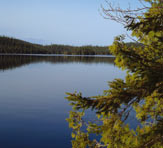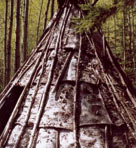  |
|
| |
Institutions > Aboriginal Land Use Planning |
| |
By "institutions" we generally refer to structures and rules that make up the forest management system of a given jurisdiction -- also called "institutional arrangements". While people also often use "institutions" to mean "organizations", that is not the primary meaning intended here. |
| |
|
| |
The difficulties with devolution: Community-based forest management planning in the Yukon under Comprehensive Land Claims (Wortley, D., N. Krogman, and D. Davidson 2001) |
| |
Kaska Forest Resources Stewardship Council
Draft Regional Forest Management Plan (Yukon, 2006) |
| |
Council of the Haida Nation Land Use Planning (BC) |
| |
Nicola-Similkameen Innovative Forest Society (BC) |
| |
"Through the Nicola-Similkameen Innovative Forestry Society, First Nations, Government and Industry are working together as equal partners to manage the six Innovative Forestry Practices Agreements (IFPAs) on the Merritt TSA.
The First Nations people have always had close ecological ties to the land. Now, through the Society, we are ensuring that our traditional values and uses will be incorporated, and even enhanced, through our contribution to the resource planning process.
First Nations are involved in decision-making regarding resource planning and management and are represented on the Society's Board of Directors and Technical Committee. Decision-making by the Board is achieved through consensus rather than by voting majority" (NSIFS website) |
| |
Dehcho Land Use Plan (NWT, 2006) |
| |
Developed under the Dehcho Interim Measures Agreement with Indian and Northern Affairs Canada, this plan involves strong leadership by Elders and traditional knowledge. The Final Draft was made available on June 12, 2006. |
| |
Heiltsuk Land Use Plan (BC, 2005) |
| |
Central Region Board Watershed Plans for Clayoquot Sound (BC) |
| |
These are landscape-level plans intended to guide logging and other forest uses in Clayoquot Sound. The Central Region Board oversees the development of these plans. The CRB is made up of Nuu-chah-nulth and provincial representatives, and serves as an advisory body to the Provincial decision-making authorities, under the terms of the Clayoquot Sound Interim Measures Agreement, first signed in 1994 but extended several times since then. The CRB's planning process can be viewed by clicking here. |
| |
Whitefeather Forest Initiative (ON) |
| |
The Whitefeather land use planning process has been led by the Pikangikum First Nation in close consultation with Elders. In June 2006, the resulting Land Use Strategy was endorsed and adopted by both the Pikangikum and the Province of Ontario. |
| |
Silva Forest Foundation Ecosystem-Based Planning |
| |
The SFF and its related consultancy, Silva Ecosystem Consultants, have done a number of land use planning projects and other projects for First Nations across Canada. Their website describes the process they use, as well as providing some project documentation. |
| |
Innu Nation Ecosystem-Based Forest Management Plans of Nitassinan (NL) |
| |
In 2003, the Innu Nation of Labrador completed a set of plans at multiple scales (landscape and operational), using an ecosystem-based approach. |
| |
|


